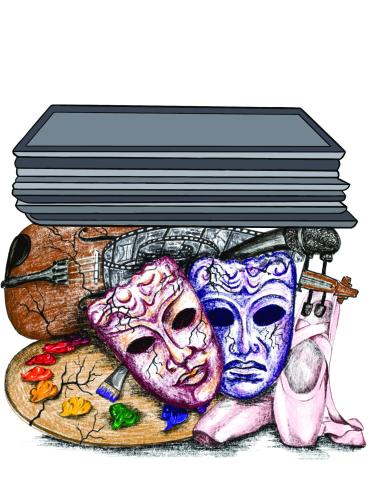#ThinkDifferent

Apple has never been afraid to “think different,” as its long-standing ad campaign has urged users. But different isn’t always better, as the tech giant found out when it infuriated the creative community with an advertisement for its latest iPad Pro model in late spring.
“In the current climate”—one in which artists face an uncertain future alongside generative artificial intelligence—“this was a bad idea, and super tone deaf,” said Steven Frost, an assistant professor of media studies at CMCI. And just weeks after the ad came out, Apple formally announced the integration of ChatGPT into iOS, compounding the misstep of an ordinarily savvy company.
“Everything exists in a context, and in the context of a place where A.I. is literally replacing creatives, this was not the moment for this ad,” Frost said.
The “Crush!” ad is 68 seconds of watching symbols of humanity’s creative achievements—sculpture, paint, music, film, video games, novels, photography—destroyed in an industrial compactor, which then opens to reveal the does-it-all iPad.
As a creator—Frost works both in digital media and as a textile artist—they understand the backlash the ad inspired, especially since Apple spent so many resources cultivating those creators as customers. But while they acknowledge the ad’s poor timing, Frost said it puts into stark relief the new reality artists must accept—either change the way they work, or risk obsolescence.
“There are definitely reasons to be suspicious of generative A.I.,” Frost said. “In order to stay relevant, we all need to evolve. Otherwise, what happens to artists when we can just ask a machine to make a postcard, a poster? Those people are going to have to learn new skills and learn how to be part of a collaborative process with those machines.”
Frost would know: They were doing art with algorithms a decade ago, manually feeding works by Gertrude Stein, RuPaul, Ta-Nehisi Coates and others into chatbots that mimicked the way those celebrities talked. So while they’re not afraid to tinker with these technologies, they do think companies that build in the A.I. space should disclose how those models were raised and their expected effect on creators.
It is, they said, the difference between imagining a future with collaborative technology, like The Jetsons, or a dystopian Black Mirror. And the companies creating these technologies need to be more collaborative, as well—not only in how we use these tools, but how and where we train them.
That lack of collaborative sentiment is what makes the Apple ad so chilling—even as it tries to evoke another commercial that seized the public imagination 40 years ago.
“The ‘1984’ ad was a breakthrough in that it reimagined what computers could be used for, and a literal breakthrough in that there’s violence and destruction at the center of it,” Frost said. “This ad is clearly referencing ‘1984.’ In a sense, they’re showing how far they’ve come and that they do all these things right, but the tone couldn’t be further from the young, upstart artist protagonist in the original ad."
Joe Arney covers research and general news for the college.

